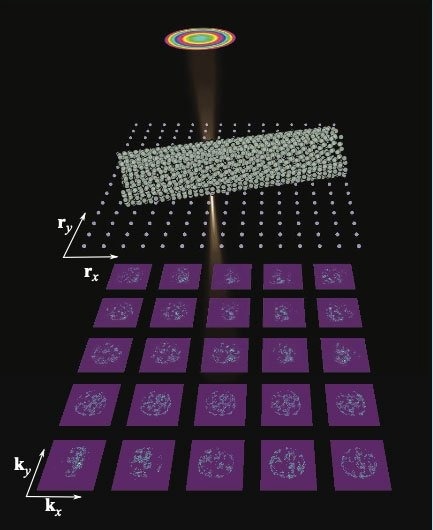Electron microscopy is being revolutionized by modern detectors. These detectors provide researchers unprecedented insights into proteins and the atomic structures of sophisticated materials, opening up hitherto uncharted territory in high-resolution imaging. At extremely short time intervals, these detectors gather data.
 In this schematic, a coherent electron microscopy beam is scanned over a carbon nanotube; the 2D diffracted image is recorded by a superfast detector for all scanned points. Image Credit: Lawrence Berkeley National Laboratory
In this schematic, a coherent electron microscopy beam is scanned over a carbon nanotube; the 2D diffracted image is recorded by a superfast detector for all scanned points. Image Credit: Lawrence Berkeley National Laboratory
They thus produce enormous volumes of data that need a significant investment of computer time and resources. This implies that contrary to what would be ideal, data analysis usually occurs after the data have been gathered rather than when the researcher is still at the microscope.
Scientists have created algorithms in this study that enable interactive, real-time data processing from massive electron microscope data sets. The methods make use of the representation of sparse data. By lowering the size of the studied data set, this data sampling approach lowers the amount of computer time and memory needed.
The Impact
The group created several methods for applying sparse data representation. With the use of these methods, researchers may choose the analytic strategy that works best for a particular experiment. Throughout the experiment, these methods offer real-time feedback on the experimental settings.
This makes it possible for researchers to instantly record certain, relevant data. For instance, they could focus on gathering information on a material’s structure. Numerous scientific domains where timely analysis is hampered by the growing number and complexity of data sets may find use for sparse data representation.
Summary
Operating at 87,000 frames per second, the 4D Camera is a novel detector that produces raw data sets of 700 terabytes. It was placed in the National Center for Electron Microscopy at the Molecular Foundry at Lawrence Berkeley National Laboratory.
After 15 seconds of processing, the data set could fill three standard laptop hard drives. Researchers might gather data but could not evaluate it in real-time due to the volume of data and the computational resources available.
There is a huge benefit to using sparse data analysis and representation. A sparse data set is produced by compressing the raw data and retaining just the information that is absolutely essential. Conventional techniques for data analysis need to decompress the data, which is a computationally demanding process.
The study team created algorithms that use the compressed data directly, cutting down on calculation time to a matter of minutes. This allows scientists to comprehend their findings while they still have time to adjust or improve their experiment.
The Department of Energy’s (DOE) Office of Science, Basic Energy Sciences program provided funding for Lawrence Berkeley National Laboratory to create the 4D camera. The tests were carried out at the DOE Office of Science user facility, the Molecular Foundry.
Journal Reference:
Pelz, P. M., et. al. (2023) Real-Time Interactive 4D-STEM Phase-Contrast Imaging From Electron Event Representation Data: Less computation with the right representation. IEEE Signal Processing Magazine. doi:10.1109/msp.2021.3120981.